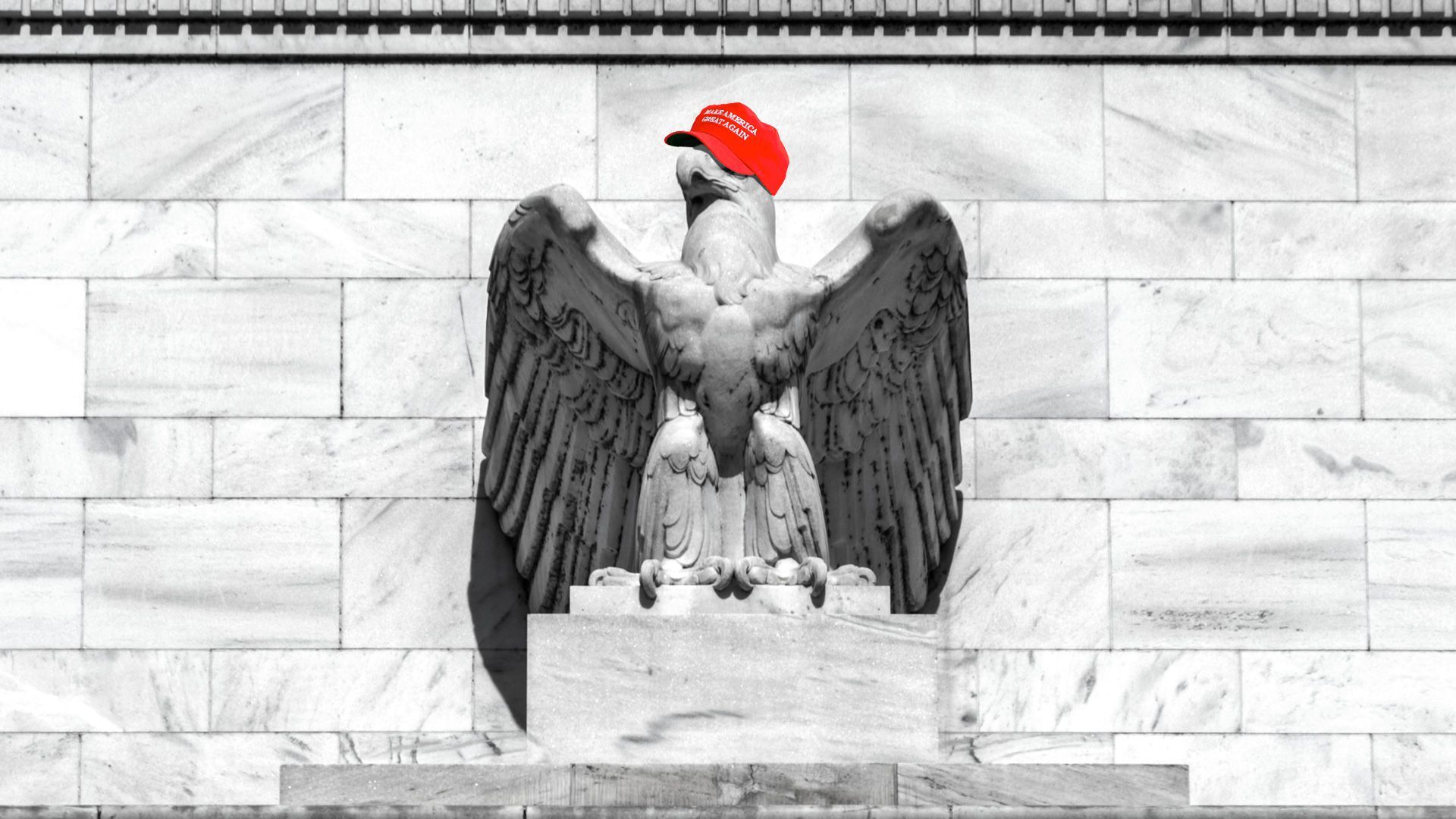| | | | | | | Presented By Raytheon Technologies | | | | Axios Markets | | By Dion Rabouin ·Dec 08, 2020 | | 🗓 Heads up! I found out my vacation days are going to expire, so I'm off for the rest of the week. Courtenay Brown will be in your inbox starting tomorrow. I'll be back with you on Monday. - Was this email forwarded to you? Sign up here. (Today's Smart Brevity count: 1,205 words, 4½ minutes.)
🎙"The facts of yesterday and today speak for themselves. The people of the United States have already formed their opinions and well understand the implications to the very life and safety of our nation." - "As Commander in Chief of the Army and Navy, I have directed that all measures be taken for our defense. But always will our whole nation remember the character of the onslaught against us." — See who said it and why it matters at the bottom.
| | | | | | 1 big thing: Why Congress is doubling down on PPP |  | | | Illustration: Sarah Grillo/Axios | | | | Renewing the Paycheck Protection Program (PPP) is one of the few things Democrats and Republicans agree on and is on the short list of must-have programs for any coronavirus relief package passed by Congress before year-end. - The only problem: PPP has been a major disappointment for small businesses.
What happened: While 5.2 million businesses received funding through the program, it left out many smaller mom and pop shops — disproportionately women-, minority- and immigrant-led firms. Millions ended up closing their doors. What we're hearing: "The headline is always 'Let's get a stimulus signed' and small business relief is part of it, but you read the fine print and what does that relief look like relative to what the need is?" says Stephen Nunes, a director at Next Street, a firm that works with small businesses and entrepreneurs from underrepresented communities - "Round 1 and round 2 were not successful. We have a far more inequitable small business ecosystem than we had in February, which was already an inequitable small business ecosystem."
Between the lines: Because Congress has spent most of its time since March bickering over the size of a bill, there has been little energy devoted to figuring out what should be included in a stimulus program that built on PPP's shortcomings. - Organizations like Next Street as well as the U.S. Chamber of Commerce, National Retail Federation and others advocated for programs like business rent forgiveness, tax breaks for PPE and cleaning expenses, hiring incentives, and expansion of low-interest loans and loan guarantees targeting underserved communities.
- Those appear to have largely been left by the wayside.
On the other side: A spokesperson for Sen. Marco Rubio, chair of the Committee on Small Business and Entrepreneurship, admits that PPP isn't perfect. - However, he highlights an October NBER study from conservative economists R. Glenn Hubbard and Michael R. Strain that found it "substantially increased the employment, financial health, and survival of small businesses."
- "PPP is the architecture. It's a program we now know is a proven method to get capital to small businesses," he tells Axios.
Keep it 💯: "At this point there is one package that seems to have bipartisan support, so the focus has to be on getting it across the finish line," Neil Bradley, chief policy officer for the Chamber, tells Axios. - "There will be opportunities, particularly as we head into the new year, to figure out further revisions and further assistance. But it's difficult to understand how that's going to happen if Congress fails to do something in this moment."
|     | | | | | | 2. Catch up quick | | A second U.S. judge blocked the Commerce Department from imposing restrictions on TikTok that would have effectively banned its use in the United States. (Reuters) China's trade balance in November was a surplus of $75.4 billion, more than $22 billion larger than forecast and the highest on record for the data series going back to 1990. (SCMP) |     | | | | | | 3. The 2-10 spread jumps |  Data: U.S. Treasury Department via FRED; Chart: Axios Visuals The difference between yields on 10-year U.S. Treasury notes and 2-year notes declined on Monday for the first time since Nov. 27, having risen by 12 basis points since then. Why it matters: The separation of longer-dated yields, which are influenced by inflation and growth expectations, from shorter-dated yields are a classic recessionary trait that has so far been much slower than in previous downturns. - Since February, when the recession officially began, the spread has risen by just 53 basis points. That's a far cry from the 2008 recession when the spread jumped 51 basis points in a month, between December 2007 and January 2008.
- Between February 2001 and November 2001, the 2-year/10-year spread jumped 143 basis points.
|     | | | | | | A message from Raytheon Technologies | | The future of aerospace and defense is here | | |  | | | | At Raytheon Technologies, nearly 200,000 engineers, scientists and researchers are pushing the limits of known science to explore deep space, advance aviation and build smarter defense systems that protect all of us here at home. That's the future of aerospace and defense. Learn more at RTX.com | | | | | | 4. BIS warns again that asset prices are disconnected from reality | | The Bank for International Settlements issued another warning about the detachment of U.S. equity prices from the real economy in its latest quarterly review. Why it matters: The so-called central bank of central banks continues to warn that the gravity-defying stock market is also defying reason. - "We are moving from the liquidity to the solvency phase of the crisis," Claudio Borio, head of the BIS Monetary and Economic Department, said on a call with reporters.
- "We should be expecting more bankruptcies going forward yet credit spreads are quite low by historical standards, and indeed while banks are pricing risk more carefully we don't see the same in capital markets."
In the latest review, BIS researchers flagged concerns about "the daylight between valuations, which are still above or near their already stretched pre-pandemic levels, and economic prospects, which are still uncertain." Flashback: This is not the first time BIS has warned about the disconnect of equity prices and economic fundamentals. - In its last quarterly review, titled "Markets rose despite subdued economic recovery," the organization said the Fed's accommodative monetary policy was responsible for "close to a half" of the runup in U.S. stock prices and "a fifth of the rebound" in European equities.
- In September 2019, BIS warned that the extreme growth in central bank balance sheets since the financial crisis had negatively impacted the way financial markets function.
- That report also found that negative impacts have been more prevalent when central banks hold a larger share of assets.
On another note: The December review also unveiled a study on the long-time correlation between stock and fixed income returns that drive the traditional 60/40 portfolio. - "Signs have emerged that the effectiveness of US Treasuries as a hedge to large equity losses may have declined in recent years."
- "The response of 10-year yields to S&P 500 sell-offs has become more muted since 2018, possibly reflecting the Federal Reserve's limited easing space."
- "As Fed officials have consistently communicated their reluctance to introduce negative interest rates, this not only puts a floor under short-term rates but also limits the potential decline of long-term nominal yields, regardless of any additional easing measures considered."
|     | | | | | | 5. Fed's consumer report shows latest sign of credit slowdown | | U.S. consumer borrowing rose by less than forecast in October while credit card debt outstanding hit a three-year low and revolving credit declined for the seventh time in eight months. Details: Total credit increased $7.2 billion from September, but revolving credit fell by $65.6 billion, reflecting a decline in credit card balances, the Fed reported Monday. The big picture: The consumer credit report comes on the heels of research from S&P Global that found loan growth at U.S. banks declined in the third quarter, as banks tightened lending standards and demand from businesses fell. - The Fed's October survey of senior loan officers found that banks were requiring higher minimum credit scores for credit cards and auto loans, and that small businesses are seeing higher collateralization requirements and higher premiums on loans.
|     | | | | | | 6. Waller becomes latest addition to Trump's Fed |  | | | Illustration: Lazaro Gamio/Axios | | | | More has been made of President Trump's three Supreme Court justice selections, but the president has put a much bigger Trump sticker on the Federal Reserve. What's happening: The Senate confirmed Christopher Waller on Thursday to the Fed's board of governors, meaning Trump has now selected five of the six governors, including Fed chair Jerome Powell. His picks account for nearly half of the voting members on the Fed's policy-setting committee. - Trump replaced outgoing vice chair Stanley Fischer with Richard Clarida and nominated Randal Quarles and Michelle Bowman.
- The entire board of governors is now made up of Republicans with the exception of Lael Brainard.
Of note: Waller was confirmed 48-47, with no votes from Democrats, and only one vote in opposition from Republicans. |     | | | | | | A message from Raytheon Technologies | | The future of aerospace and defense is here | | |  | | | | At Raytheon Technologies, nearly 200,000 engineers, scientists and researchers are pushing the limits of known science to explore deep space, advance aviation and build smarter defense systems that protect all of us here at home. That's the future of aerospace and defense. Learn more at RTX.com | | | | Thanks for reading! Quote: "The facts of yesterday and today speak for themselves. The people of the United States have already formed their opinions and well understand the implications to the very life and safety of our nation." - "As Commander in Chief of the Army and Navy, I have directed that all measures be taken for our defense. But always will our whole nation remember the character of the onslaught against us."
Why it matters: On Dec. 8, 1941, President Franklin D. Roosevelt delivered his "Day of Infamy" speech to a joint session of Congress the day after Japan's surprise attack on Pearl Harbor. Within an hour of the speech, Congress passed a formal declaration of war against Japan and officially brought the U.S. into World War II. | | | | Axios thanks our partners for supporting our newsletters.
Sponsorship has no influence on editorial content. Axios, 3100 Clarendon Blvd, Suite 1300, Arlington VA 22201 | | | You received this email because you signed up for newsletters from Axios.
Change your preferences or unsubscribe here. | | | Was this email forwarded to you?
Sign up now to get Axios in your inbox. | | | | Follow Axios on social media:    | | | | | |






No comments:
Post a Comment